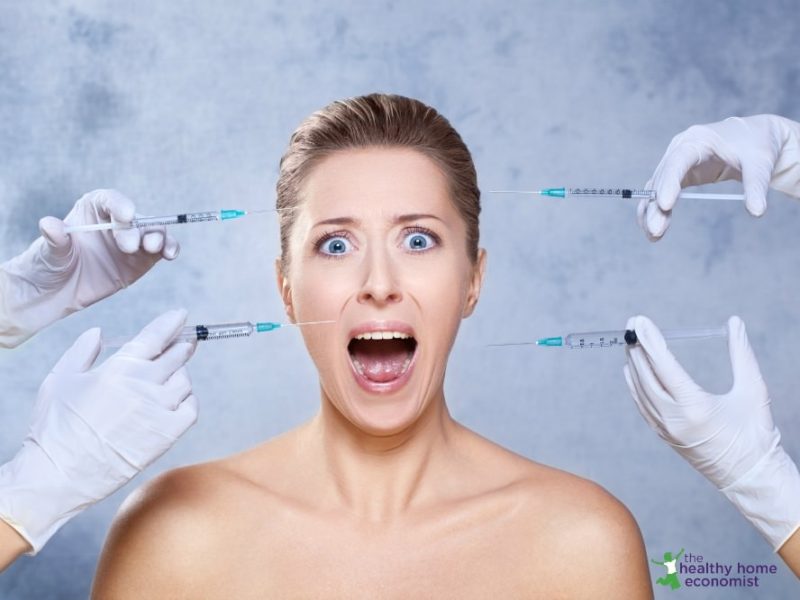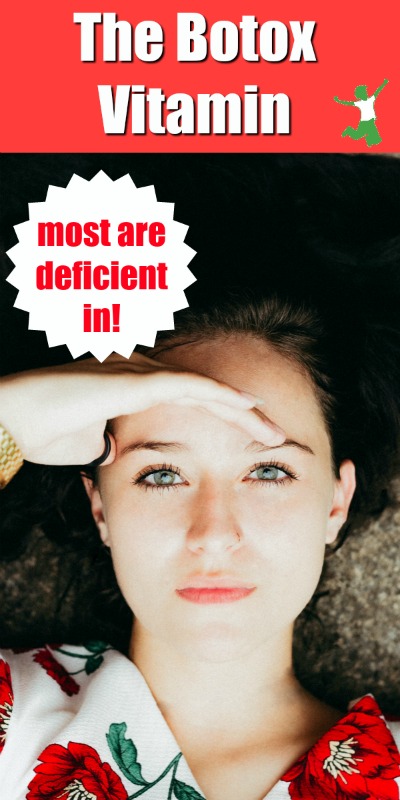Table of Contents[Hide][Show]
The vitamin deficiency that is widespread and most tellingly shows up as excessive wrinkling of the face.

Are wrinkles an inevitable fact of aging, or could laugh lines and crow’s feet potentially indicate a vitamin deficiency or even a more serious underlying health issue?
At a meeting of the Endocrine Society in Boston, researchers presented findings that revealed that women in their 40s and 50s who have extensive skin wrinkling are much more likely than their peers to have low bone mass. (1)
Researchers noted the relationship between wrinkles and bone density in every single bone tested which included hip, heel, and lumbar (spine).
In addition, this relationship existed regardless of body fat percentage and age.
Epidemiological evidence of Asian women offers further health clues to the wrinkle mystery. (2)
It is known that Japanese women have fewer wrinkles and less skin sagging that women of the same age living in North America.
These two groups of women vary greatly in diet and lifestyle, however.
Even when Japanese women living in Tokyo were compared with women from the Asian cities of Shanghai and Bangkok, they showed the least visible signs of aging.
Diet and lifestyle factors for these three Asian groups of women are comparable, except for one notable exception: consumption of natto in Japan.
Vitamin K2. The Anti-Wrinkle Vitamin
Tokyo residents frequently enjoy natto, a strong-smelling food traditionally made from fermented soybeans for breakfast.
Natto is loaded with menaquinone, more popularly known as Vitamin K2, and blood samples of the Tokyo women revealed high circulating levels of this fat-soluble vitamin.
Soy-free natto is also high in K2, as it is the specialty probiotic culture that imparts the nutrient, not the legume itself.
Further research bolstering the notion that getting plenty of anti-wrinkle vitamin K2 in the diet makes for smoother facial features is found in the research of Korean scientists and was published in the journal Nephrology. (3)
The rate at which the kidneys are able to filter the blood is an important measure of overall kidney function.
Researchers found that reduced renal filtration rate was associated with increased facial wrinkling.
What does decreased kidney filtration rate predict?
You guessed it – Vitamin K2 deficiency, according to American research published the year after the Korean study.
90% Deficiency Rate!
Testing has been limited so far on the true extent of Vitamin K2 deficiency in the western world.
However, of the testing conducted so far, a whopping 90% of people are deficient in this critical nutrient.
No wonder botox is such a popular cosmetic treatment!
No surprise that the sacred foods of traditional cultures were some of the highest Vitamin K2 containing foods!
Foods with the Anti-Wrinkle Vitamin
If you want to avoid a vitamin deficiency of K2, know that it is an elusive nutrient and extremely difficult to obtain with a modern diet.
The highest sources of K2 are:
- Natto (fermented soybeans)
- Goose liver
- Certain cheeses (Gouda has the most K2)
- Animal fats like egg yolk, butter, butter oil, ghee, and lard which must come from grassfed animals.
Natto contains 1,103 mcg of K2 per 3.5 ounce/100 gram portion which is far higher than any other food.
The second highest food in Vitamin K2 is goose liver pate which has 369 mcg per 3 1/2 ounce portion.
While delicious and wonderful to eat, goose liver pate is very hard to find in most places. It is also a very high-end, gourmet food, which makes the price out of reach for most.
Rounding out the top 3 foods highest in Vitamin K2 is none other than the humble Gouda cheese, which boasts 75 mcg per 3 1/2 ounce serving!
Brie contains significant K2 as well.
This compares to pastured egg yolks and butter, which each have about 15 mcg of K2 per 3 1/2 ounce portion.
How much of these K2 containing foods should you eat to avoid a vitamin deficiency of this critical nutrient?
That part gets murky as the official recommended daily intake (RDI) of Vitamin K doesn’t distinguish between K1 and K2 despite their very different uses in the body.
The RDI for Vitamin K is only determined by the liver’s requirement for normal blood clotting factors, not the K2 needed for optimal bone and kidney health and wrinkle-free skin.
Thus, getting enough K1 in the diet via leafy greens could still mean a serious deficiency of Vitamin K2.
There is also no solid evidence that the human body is able to convert Vitamin K1 to Vitamin K2, which is what occurs in grazing animals.
The good news is that there is no known toxicity of Vitamin K2, unlike other fat-soluble vitamins.
So, eating generously of Vitamin K2 rich foods as practiced by Traditional Societies and even potentially taking a supplement to avoid a vitamin deficiency is considered wise by Dr. Kate Rheaume-Bleue, ND, author of Vitamin K2 and the Calcium Paradox.
Plant vs Animal K2
Vitamin K2 is available in both animal fats and fermented foods. The animal form is MK-4 and the fermented form is MK-7.
Recent research has shown that emu oil, an Aboriginal sacred food, is extremely high in MK-4, nearly as high as goose liver pate!
This vetted source of pastured emu oil from a genetically pure strain of birds eating their native diet is the type to source.
Some people claim that putting emu oil directly on the skin is also helpful for anti-wrinkling effects. It certainly can’t hurt to try this, but I would not rely on transdermal emu oil alone. Eating high Vitamin K2 foods regularly is crucial.
Note that not all emu oil contains K2…only the fat from pastured birds!
For those who prefer the fermented form of K2 (MK-7), this quality brand offers therapeutic doses of the wrinkle-reducing vitamin from nonGMO natto extract.
As for me, I prefer to get nutrients from food as much as possible. While I will take Vitamin K2 supplements in a pinch, I am currently eating 1-2 tablespoons of homemade natto (MK7 form of Vitamin K2) and 1/2 teaspoon of grassfed ghee (MK4 form of Vitamin K2) every day as my whole food sources. When combined with a traditional diet, this provides about 200-400 mcg of Vitamin K2 per day.

(1) No Joke! Laugh Lines May Reveal Bone Health
(2) Vitamin K2 and the Calcium Paradox: How a Little-Known Vitamin Could Save Your Life
(3) Facial wrinkles as a predictor of decreased renal function
More Information
The Best Vitamin K 2 Supplement
Benefits of Vitamin K2
Macrobiotic Diet and Extreme Vitamin Deficiency
Emu Oil Benefits








What are geese fed these days? I hope not the gmo corn & soy crap that all the other animals are fed these days. Now alfalfa too.
I have a hard time getting organic liver here in France. The European Union has allowed GMO feed for animals sometime ago. Plus GMO potatoes are now allowed to be grown for animal feed – going through the backdoor, so-to-speak. And I’ve never seen labels identifying GMOs here.
I’ve been saying that when people say there is no GMO in Europe. Exactly, it’s through the back-door in the animal feed.
Where can you find a trusted source of GMO-free Natto?
In theory, these suggestions would work well. In reality, it’s hard to find them, because of GMO contamination and other issues. Give us real places or sources we can get un-GMO-contaminated products. The choices are getting narrower & narrower because Monsanto & friends are getting the noose tighter & tighter on us, where one day, we will no longer have a choice. Sorry for the message delivery, but I hope people realize how serious the situation is.
Fats along with natural myofunctional therapy. http://www.youtube.com/watch?v=zaQQdyaymZc
I was researching some things you posted about soy and natto, and I’m a little confused being that there are so many post about how soy is so bad for us. Here is a bit of one of your posts.
Be sure not to be taken in by the argument that because soy is organic, nonGMO or sprouted that it is just fine to eat it. Fermented soy in small, condimental amounts as practiced in traditional Asian cultures is the only safe way to consume this legume and even then, only for those who have healthy thyroid function because it is so extremely goitrogenic. Miso, tempeh, natto and soy sauce (IF traditionally brewed) fall under this category.
So is it safe for us to take the MK-7 that comes from natto? Does the daily dosage fall under the “small amount”. And if natto is a natural plant estrogen is it something I should give to my sons and husband?
I truly respect your opinions and your research. Thank you for helping change my family’s life!
since I started giving the kids gouda cheese , a cavity which my child had stopped decaying further.
we buy goose liver pate in farmers market here in Ontario, it is not very expensive by the way the way. kids love it on bread.
My kids all love liver pâté on bread with mustard. I craved it while pregnant.
It’s unwise to think that an Asian style diet would produce the same results in American women of European descent. We have very different biochemistry and abilities to digest certain foods. For example, I am HIGHLY sensitive to soy, it gives me extreme digestive upset. Just as Asian and Japanese women tend to have difficulty digesting dairy products. Perhaps the K2 is an answer. Perhaps there are others as well. I believe, though, that the biggest problem we have in our diets is what has been ADDED to them that shouldn’t be there, rather than what is lacking.
Of course genetics are different, but it can’t hurt to look at what they are doing differently to give them different results, can it? You may be sensitive to soy, but have you tried Natto? the point is that it’s very fermented, as is miso. Unfermented soy products, such as tofu and soymilk, are never recommended for lots of reasons. Everyone is sensitive to those, whether they realize it or not, because they are mostly indigestible to humans, and the phytoestrogens are toxic to our endocrine systems. No one is recommending you eat soy. Small amounts of fermented soy, however, have their benefits. Fermentation is key.
Goose liver? Gross, lol….. Kale has a lot of vitamin K. I don’t know the difference in K and K2 though.
Japan also does not fluoridate its water and fluoride has been shown to increase hip fractures. I wonder if that plays a role in their health?
I think I’ll buy some gouda :). Getting K-2 through soy makes me a little nervous. I’m not allergic, but I do try to avoid soy because of my thyroid and because of estrogen factors. I’m not sure I can get passed that…
I am from Japan and we usually eat natto for breakfast. We mix it with raw egg (or egg yolk), sauce that comes with the package of natto (or soy sauce), some sliced scallions and sprinkles of nori. Pour it over hot rice. It smells and also stringy but my children and I love it! My husband from Australia didn’t like it first but he eats it now.
Yum! This reminds me of the time I spent in Japan teaching English. I loved the Japanese food, especially breakfast!
When my face became extreamly wrinkled it was my thyroid.